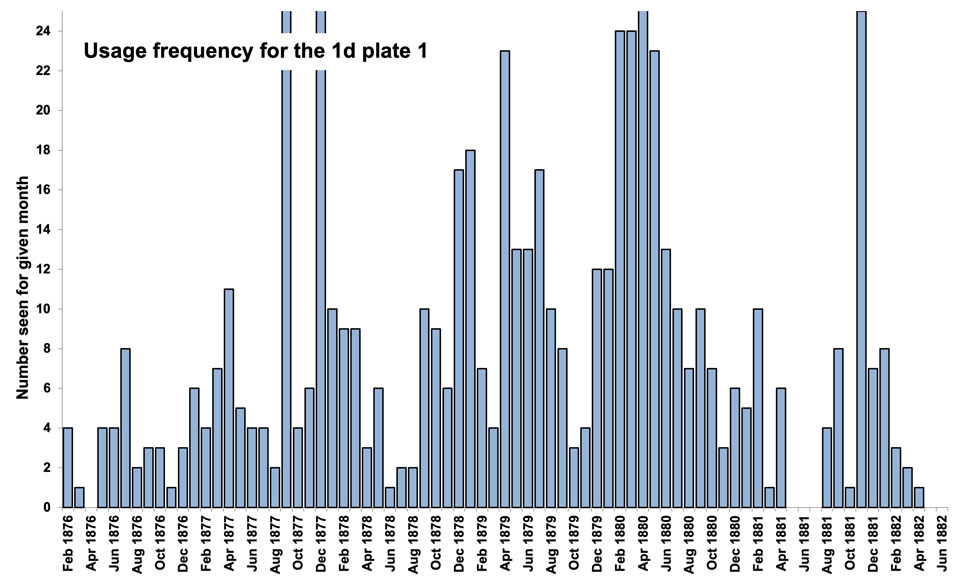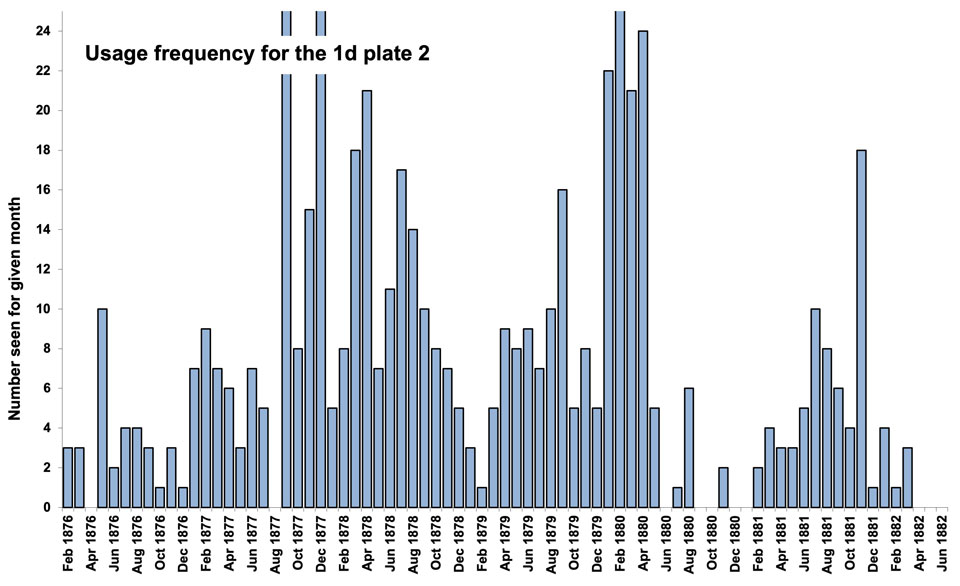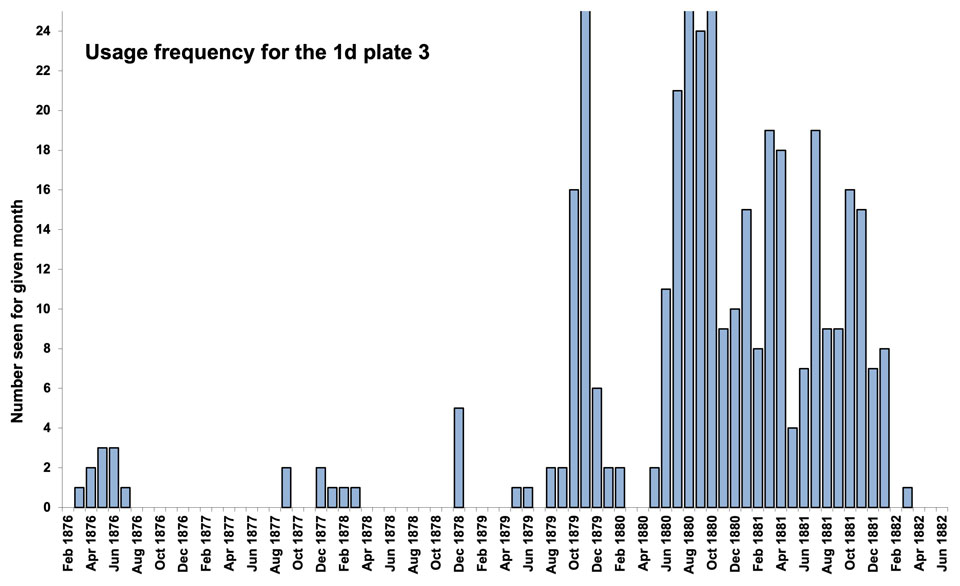1 Essays
2 Die Proofs
3 Sheet Layout
4 Plate Proofs
5 Paper
6 Imprimaturs
7 Colour Standards
8 Specimens
9 Issued Stamps

Date: 1 Feb 1876
Plates: 1-5
Printer: De La Rue
Watermark: Shamrock
Perforation: 14
The 1d Telegraphs was issued on 1 Feb 1876 together with 3d, 1s, and 5s values. However, no example of any telegraph stamp has been found dated earlier than 4 Feb 1876.
It had been decided that telegraph stamps of the same value as postage stamps would be printed in the same colour and on the same paper as the corresponding postage stamps, but as De La Rue were not printing the 1d postage stamps at the time, they printed the 1d value on paper that they had in use for Irish dog license stamps.
The 1d value was needed to pay the telegraph receipt fee and for additional charges on press telegrams, but the demand was overestimated, and supplies from the first three plates lasted the entire period of the telegraphs issue. The stock of sheets from plate 4 was destroyed when telegraph stamps were discontinued, and plate 5 was altered for use as the ½d stamp.
Essays



Three essays for the 1d value were prepared by De La Rue for the first issue: Series A and Series B essays dated “24 MAR 75”, and the approved design submitted on 31 Mar 1875.
| A | 1d | 55 | AB | purple-brown |
| B | 1d | 55 | AB | brown |
| C | 1d | 55 | AB | red-brown, approved design |
For more details on first issue essays click here.


The first essay above has a printed head pasted into a hand painted frame and is dated “8 APR 79”. The second is from a set of 12 black & white essays which are undated but believed to be circa 1880. Their purpose is not known, but they are likely not related to the issued stamps.
| — | 1d | — | — | printed head, brown frame |
| — | 1d | — | — | black & white |
For more details on additional essays click here.
Die Proofs
Die proofs are printed in black on white glazed card, typically 92 x 60mm, unless otherwise noted. They are listed below ordered by date, with undated proofs following those with the same plate number. The rightmost column gives the number recorded in our database: in private hands + institutionalised.

To see more 1d Die Proofs click here.
| 1 | July 1, 1875 | — | — | — | 1 |
| 2 | July 6, 1875 | — | — | “BEFORE HARDENING” | 5 + 2 |
| 3 | no date | — | — | Basic Die Proof | 1 + 2 |
| 4 | July 14, 1875† | 1 | AA | Cut down to stamp size | 1 |
| 5 | July 22, 1875 | 1 | AA | “BEFORE STRIKING” | 1 |
| 6 | July 22, 1875 | 1 | AA | “After Striking” in manuscript | 1 |
| 7 | July 22, 1875 | 2 | AA | “BEFORE STRIKING” | 1 |
| 8 | no date | 2 | AA | — | 1 |
| 9 | July 26, 1875 | 3 | OL | “BEFORE STRIKING”, (“JPS”)* | 1* |
| 10 | July 28, 1875 | 4 | FC | “BEFORE STRIKING” | 1 |
| 11 | Aug 6, 1875 | 5 | — | “AFTER STRIKING” | 1 + 1 |
* Recorded with and without initials, likely the same one.
† On back: “App on 15.7.75 / struck 14.7.75 / after hardening”.
Institutionalised/Total: 5/20.
From the Striking Books




| July 22, 1875 | — | — | “1875 July 22 …” | 1 |
| July 28, 1875 | 3 | SA | “July 28 75” | 1* |
| July 30, 1875 | 4 | LB | “July 30 ’75 / 240 Leads” | 1 |
| Aug 6, 1875 | 5 | PA | “Aug 6 / 240 Leads”, “Aug 30 …” | 1 |
* Reconstruction.
In a Countersunk Frame

| no date | — | — | Cut down, set in a countersunk frame | 2* |
* Other values have both cream and buff frames. A buff frame may exist, but has not been seen by us.
Sheet Layout
The sheet had 240 stamps in one large pane, arranged as 12 rows of 20. Above the pane was “TELEGRAPHS ONE PENNY.” with an elaborate division ornament between the words and repeated below the pane. Plate numbers were left of AB and right of TK, current numbers left of AK and right of TB. At the middle of each side was a cross and a horizontal line used as guides for perforating.
A Post Office sheet was the entire sheet, valued at one pound.

Computer generated image, click to enlarge.

Elaborate division ornament.
Plate Proofs

No plate proofs are recorded for this value. However, an illustration in Wright and Creeke shows an imperforate example of plate 4 lettered BJ, and the margins do not match those of the imprimatur, which exists. This example may no longer exist, or it could be waiting to be found.
Paper
De La Rue used the paper they had in use for Irish dog license stamps, which was laid out in 12 rows of 20 with watermark Shamrock. This paper was also used for the ½d, £1, and £5 values.


The watermark as seen from the front of the stamp.
For more details on Shamrock paper click here.
Imprimaturs




Plates 1 & 2 were registered on 11 Aug 1875, plates 3 & 4 on 16 Aug 1875.


Plate 5 was registered on 30 Aug 1875 but altered for use as the ½d stamp. The example is shown with a matched imprimatur for the ½d value lettered TD taken after the plate was altered from 1d to ½d.
The registration sheets for the Telegraphs have been lost. However, we can reconstruct them from known examples and a clear pattern emerges. Most have a column of 12 taken, plus four from the adjacent column, and a plate number example from the opposite corner. One sheet of each value has an extra column of 12 taken.
Red represents an institutionalised example.
Green a known example in private hands.
Blue is unknown but predicted by the pattern.

| Institutionalised/Total: | 9/18 |
| Royal Philatelic Collection: | AA-AB, TK |
| British Postal Museum: | SI, SK |
| German Postal Museum: | — |
| Tapling Collection: | TJ |
| Langmead Collection: | TB |
| Phillips Collection: | TC, TH |

| Institutionalised/Total: | 9/18 |
| Royal Philatelic Collection: | AA-AB, TK |
| British Postal Museum: | SA, SB |
| German Postal Museum: | — |
| Tapling Collection: | TC |
| Langmead Collection: | TB |
| Phillips Collection: | TE, TJ |

| Institutionalised/Total: | 9/18 |
| Royal Philatelic Collection: | AA-AB, TK |
| British Postal Museum: | SI, SK |
| German Postal Museum: | — |
| Tapling Collection: | TF |
| Langmead Collection: | TB |
| Phillips Collection: | TE, TI |

| Institutionalised/Total: | 9/18 |
| Royal Philatelic Collection: | AB, TK-TL |
| British Postal Museum: | BK, BI |
| German Postal Museum: | — |
| Tapling Collection: | AH |
| Langmead Collection: | AK |
| Phillips Collection: | AD, AF |

| Institutionalised/Total: | 12/30 |
| Royal Philatelic Collection: | AA-AB, TK |
| British Postal Museum: | RB, RD |
| German Postal Museum: | SI |
| Tapling Collection: | TF |
| Langmead Collection: | SA-SB, TB |
| Phillips Collection: | TC, TI |
Colour Standards

No colour standard sheet is recorded for the 1d; however, there are many blocks of 1d plate 1 Specimen Type 10 which are very likely colour standards. These specimens were not used in contemporary sets (plate 2 was used) and the division into blocks is typical of other colour standards, the freshness indicating the sheet was intact until quite late.
Red represents an institutionalised example.
Green a known example in private hands.

PI is in the Langmead Collection.
Click the images to enlarge.
Specimens



Plate 1 Type 9: watermark inverted, scarce, one block of 4 and an irregular block of 31 known, from one sheet.
Plate 1 Type 9b: common, blocks of 4 (x8), 5 (x3), 8, 9 (x4), 11, 12 (x3), 16, 26, 32 (x2), 47 and 50 known, from three sheets.
Plate 1 Type 10: common, colour standard (see above), from one sheet.




Plate 2 Type 8: possibly unique, no gum, maybe from an official document.
Plate 2 Type 9: scarce, blocks of 4 (x5) and 28 known, from one sheet.
Plate 2 Type 10: scarce, from contemporary “sets”, blocks of 4 (x3) and 9 known, from one sheet.
Plate 3 Type 9: scarce, blocks of 4 (x3), 6, 38, 40 and 55 known, from one sheet.
Click the images to enlarge.
Reference to scarcity, blocks and the number of sheets or panes so treated is derived from reconstructions of known examples within our database.
Issued Stamps
Stamps were issued from plates 1, 2, and 3. Sheets from plate 4 were destroyed when telegraph stamps were discontinued, and plate 5 was altered for use as the ½d stamp.
The usage frequency graphs show that plates 1 & 2 were used across the whole period of the telegraphs issue, suggesting just how much the Inland Revenue had overestimated the requirement for this value. Plate 3 was used predominantly towards the later end of the period with some sheets being distributed quite early.
Click the graphs to enlarge.

For postal, fiscal, and railway usage click here.
Issued Stamps — Plate 1
Plate 1 (current no. 480) was registered and put to press on 11 Aug 1875. It was taken from press on 25 Nov 1875 after printing 35,000 sheets.
Scarcity #2 in mint telegraphs, #5 in used telegraphs.


Mint examples are the second most common of all the mint telegraph stamps (the ½d is the most common). Mint multiples are scarce for all the 1d plates beyond pairs. For plate 1, several blocks are in our database, including six blocks of four (two with plate number), and blocks of 10, 12 and 16 (with current number).
Used multiples beyond pairs are rare. There are two strips of three and one block of six known to us. The earliest known used examples are 17 Feb 1876 at Dover Pier and at Sheffield (illustrated). The official issue date was 1 Feb 1876; however, no example of any telegraph stamp has been found dated earlier than 4 Feb 1876.
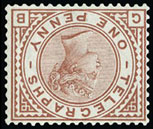

Inverted watermarks are rare, but both mint and used examples are in our database. The only multiple known to us is a block of four but it has been split into singles.
Click the images to enlarge.

The primary use of the 1d value was to pay the 2d telegraph receipt fee, either with two singles or a pair. This should have been the only way that used stamps were available to the public, all others should have been destroyed along with the forms they were used on.
Issued Stamps — Plate 2
Plate 2 (current no. 481) was registered and put to press on 11 Aug 1875. It was taken from press on 21 Jan 1876 after printing 35,000 sheets.
Scarcity #4 in mint telegraphs, #8 in used telegraphs.


Mint multiples are scarce for all the 1d plates beyond pairs. For plate 2, five blocks of four are in our database, including a current number block, but no plate number block. No larger multiples are known to us.
Used multiples beyond pairs are rare. One strip of three, three blocks of four, and a block of eight are in our database. The earliest known used example is 4 Feb 1876 at Liverpool Corn Exchange (illustrated), earlier than the earliest used plate 1.


Inverted watermarks are rare, but both mint and used examples are in our database. The only multiples known to us are two blocks of four, one a perfined “G&Co”.
Click the images to enlarge.
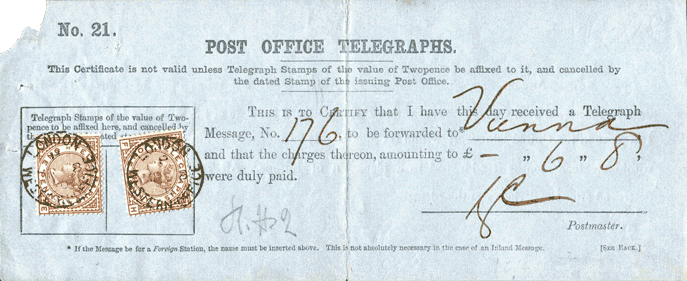
Telegraph receipts were printed on various shades of blue paper. This one is quite pale and is cancelled with two single plate 2 stamps.
Issued Stamps — Plate 3
Plate 3 (current no. 482) was registered on 16 Aug 1875 and put to press on 17 Aug 1875. It was taken from press on 17 Feb 1876 after printing 35,000 sheets.
Scarcity #8 in mint telegraphs, #12 in used telegraphs.


Mint multiples are scarce for all the 1d plates beyond pairs. For plate 3, four of blocks of four are in our database, including a plate number block. No larger multiples are known to us.
Used multiples beyond pairs are rare. One block of nine is in our database. The earliest known used example is 30 Mar 1876 at Bristol Telegraph Department (illustrated).


Inverted watermarks are rare. No mint examples are known to us, and only two used examples both Liverpool Exchange, 21 Nov 1879 and 26 Nov 1879.
Click the images to enlarge.

This receipt has a pair of plate 3 stamps cancelled on 4 June 1880.
Issued Stamps — Plates 4 & 5
Plate 4 (current no. 483) was registered on 16 Aug 1875 and put to press on 17 Feb 1876. About 5,000 sheets were printed, then destroyed when telegraph stamps were discontinued. Imprimaturs exist, but no perforated examples are known.
Plate 5 (current no. 484) was registered on 30 Aug 1875 and approved on 23 Sept 1875. It was then altered for use as the ½d stamp. Only the registration sheets were printed. Imprimaturs exist, but no perforated examples are known.














